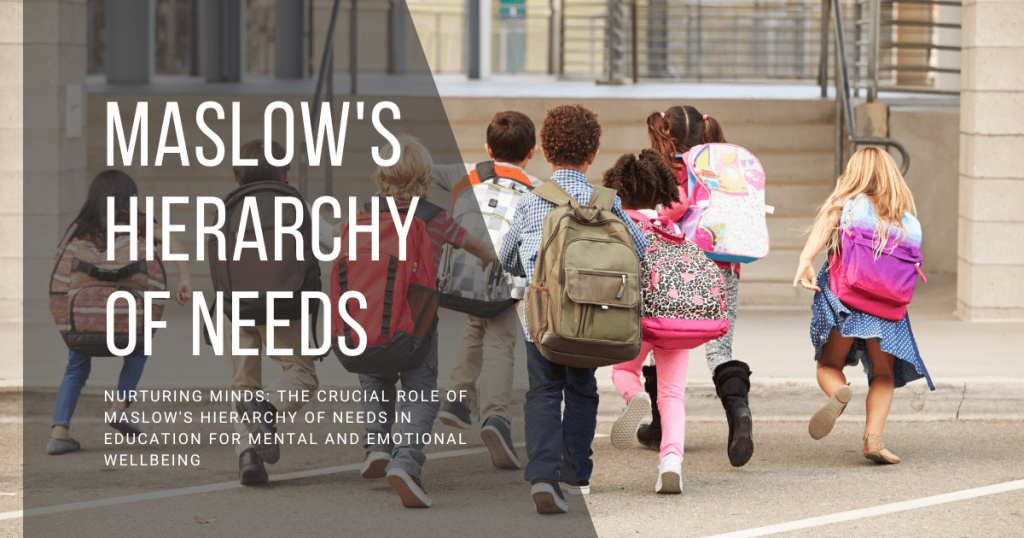Introduction:
In the complex landscape of education, where the focus often centers on academic achievements and standardized testing, there is a growing recognition of the importance of prioritizing the mental and emotional wellbeing of young people. Abraham Maslow’s Hierarchy of Needs, a psychological theory that outlines human needs in a hierarchical structure, offers invaluable insights for educators aiming to create an environment that fosters holistic development.
This blog explores the significance of understanding Maslow’s Hierarchy of Needs in the context of educating young minds, with a particular emphasis on promoting mental and emotional wellbeing.
Physiological Needs
At the very core of Maslow’s Hierarchy lies a fundamental layer — physiological needs. These encompass the absolute essentials required for human survival: air, water, food, shelter, and sleep. Think of them as the building blocks upon which the entire structure of life and development rests. In the world of education, recognizing and fulfilling these basic needs isn’t just a checkbox exercise; it’s about creating the optimal conditions for effective learning.
In the context of education, the importance of tending to physiological needs can’t be overstated. It’s not merely about acknowledging that humans need air to breathe and food to eat; it’s about understanding how these basic elements profoundly impact the learning journey. A student battling hunger pangs or struggling with fatigue is naturally less inclined to be an active and engaged participant in the educational process. Therefore, educators face the crucial task of ensuring these foundational needs are met to establish an environment that truly fosters learning.
Imagine a student walking into school after a night of tossing and turning or on an empty stomach. In such scenarios, the cognitive functions necessary for effective learning take a hit. The brain, deprived of essential nutrients and proper rest, finds it challenging to focus and absorb information. Acknowledging this reality, schools are increasingly adopting holistic approaches that go beyond traditional teaching methods. Initiatives like nutritious meal programs, ample break times, and mindfulness practices are gaining traction, recognizing the intrinsic connection between physiological well-being and academic success.
Maslow’s emphasis on physiological needs speaks directly to the heart of education, urging institutions to be proactive in addressing these basic requirements for sustenance and vitality. By doing so, educators fulfill not just their role in promoting academic growth but also contribute significantly to the overall well-being of each student. It’s about creating a sturdy foundation upon which a thriving and resilient learning community can be built.
Safety and Security:
As we climb Maslow’s Hierarchy, the second tier places a crucial emphasis on safety and security. In the realm of education, this extends beyond the traditional concept of physical safety to encompass the equally vital realms of emotional and psychological security. It’s not just about fire drills and emergency protocols; it’s about creating educational spaces that act as both physical and emotional sanctuaries, promoting the overall well-being of students.
In the educational context, ensuring safety and security involves more than just routine safety measures. It calls for the creation of a culture where emotional and psychological safety are at the forefront. Imagine a school where students not only feel shielded from physical harm but also find emotional security—a space where they can express themselves freely, take intellectual risks, and engage in the learning process with a profound sense of belonging.
At the heart of this concept is the understanding that emotional security is not a luxury but a fundamental requirement for positive mental health. When students feel emotionally safe, they are more likely to form authentic connections, navigate challenges with resilience, and develop the emotional intelligence necessary for success in and beyond the classroom.
Building a secure emotional space involves implementing strategies that foster open communication, active listening, and empathy within the school community. Teachers and staff play pivotal roles in creating an atmosphere where students feel heard, valued, and supported. Initiatives like peer mentoring programs, regular check-ins, and designated spaces for self-reflection contribute to cultivating a culture of emotional security that extends well beyond academic pursuits.
Additionally, recognizing the diverse backgrounds, experiences, and perspectives of students is integral to establishing a genuinely secure educational environment. Inclusive practices, cultural competence training for educators, and a commitment to understanding the unique needs of each student significantly contribute to the emotional safety net that schools can provide.
In essence, the emphasis on safety and security in Maslow’s Hierarchy aligns with the core ideals of education—a nurturing haven that not only safeguards physical well-being but also cultivates emotional resilience. It’s a call for schools to become spaces where students don’t just survive academically but thrive emotionally and psychologically, setting the stage for a future generation equipped with the tools to navigate life’s complexities with confidence and compassion.
Social Belonging:
Our attention turns from basic physiological and safety needs to the profound importance of social belonging. In the context of education, this stage isn’t just about setting up classrooms; it’s about creating a school environment that feels like a supportive and inclusive community.
Social belonging is all about building positive relationships among students, teachers, and staff. It goes beyond mere coexistence; it’s about cultivating connections that extend beyond the academic world. This commitment to fostering a sense of connection and shared purpose becomes a cornerstone in shaping the overall educational experience.
In a school community that prioritizes social belonging, students find themselves in an atmosphere that values and celebrates diversity, creating a web of interconnectedness. Positive relationships form the foundation, providing students with a sense of security and acceptance. It’s not just about physically being present; it’s about feeling like an integral part of a community that recognizes individual strengths and unique contributions.
When students feel a genuine sense of belonging, they are more likely to actively engage in the learning process. The classroom becomes a space where curiosity is nurtured, ideas are shared, and collaboration thrives. This active participation goes beyond academic achievement; it extends to the development of essential life skills, including communication, teamwork, and empathy.
Moreover, the impact of social belonging goes beyond academics, serving as a crucial pillar for students’ mental and emotional well-being. In a community that values and accepts its members, students are better equipped to navigate the inevitable challenges of adolescence. The sense of belonging acts as a buffer against feelings of isolation and loneliness, contributing significantly to a positive school culture.
Creating a culture of social belonging involves intentional efforts to break down barriers and build bridges within the school community. Initiatives such as mentorship programs, peer support networks, and collaborative projects contribute to the sense of connection and inclusivity. Teachers play a pivotal role in modeling positive relationships, fostering an environment where each student feels seen, heard, and valued.
In essence, social belonging is not just a component of education; it is a fundamental principle that shapes the very fabric of a school’s culture. It goes beyond academic achievements, reaching into the realms of emotional and psychological well-being. Schools that prioritize social belonging create environments where students not only learn but also thrive as individuals, empowered by a sense of community that celebrates their unique identities and contributions.
Esteem
Our focus shifts to the tier of esteem needs—an essential stage that encompasses both self-esteem and the recognition gained from others. In the context of education, this phase involves a nuanced approach to acknowledging and celebrating individual achievements, spanning academic successes and personal milestones.
Teachers play a pivotal role in nurturing students’ self-esteem, acting as influential figures in shaping how students perceive themselves and their capabilities. Offering constructive feedback becomes a powerful tool, providing students with insights into their strengths and areas for improvement. By acknowledging their efforts, teachers not only validate hard work but also contribute to fostering a growth mindset—a perspective that sees challenges as opportunities for learning and personal development.
Within the educational environment, creating a space that encourages healthy competition further supports the development of self-esteem. Far from fostering a cutthroat atmosphere, healthy competition allows students to showcase their unique skills and talents. This not only contributes to the cultivation of a positive self-image but also instills a sense of pride and accomplishment in their abilities.
Recognition and celebration of achievements, regardless of their scale, establish an environment where students feel valued and acknowledged for their contributions. This positive reinforcement extends beyond its immediate impact on academic performance, resonating in the holistic development of the individual. When esteem needs are met, students are better equipped to navigate the challenges of their educational journey with a heightened sense of competence, confidence, and accomplishment.
To further address esteem needs, educators can implement personalized recognition systems that acknowledge diverse forms of achievement. This might involve spotlighting academic successes, artistic talents, leadership qualities, or acts of kindness. By adopting a holistic approach to recognizing achievements, educators create an inclusive environment that respects and values the diverse strengths and attributes each student brings to the learning experience.
The tier of esteem needs in Maslow’s Hierarchy is not merely a checkpoint but a pivotal stage in shaping students’ attitudes and perceptions about themselves. By prioritizing esteem needs, educators contribute significantly to the well-rounded development of students, fostering a positive self-perception that transcends the academic realm and influences broader aspects of mental and emotional well-being.
Self-Actualization:
At the apex of Maslow’s Hierarchy lies the pinnacle of self-actualization—a stage that embodies the fulfillment of one’s potential and the pursuit of personal growth. In the context of education, this transcendent tier calls educators to create an environment that not only imparts knowledge but also nurtures the flourishing of each student’s individual capabilities.
The pursuit of self-actualization within the educational realm encompasses a multifaceted approach. It entails providing students with diverse opportunities to explore their passions, delve into areas of personal interest, and unearth latent talents. This involves moving beyond the conventional curriculum, offering enrichment programs, extracurricular activities, and platforms for self-discovery that allow students to connect with subjects that resonate with their unique interests.
Developing critical thinking skills becomes a key facet of the journey toward self-actualization. Education should not merely be about rote memorization and regurgitation of facts; it should be a dynamic process that stimulates curiosity and analytical thinking. Encouraging students to question, analyze, and synthesize information fosters a mindset of inquiry that is fundamental to the self-actualization journey.
Furthermore, creative expression serves as a powerful conduit for self-actualization. The arts, sciences, and humanities offer students diverse avenues through which they can channel their creativity. Providing platforms for artistic expression, whether through visual arts, performing arts, or creative writing, empowers students to communicate their thoughts and emotions in unique and meaningful ways. In doing so, educators foster an environment where self-expression becomes a vital component of the learning experience.
Encouraging autonomy and self-directed learning stands as a cornerstone of the self-actualization process. Empowering students to take control of their educational journey involves more than providing choices; it entails instilling a sense of responsibility and ownership over their learning. This approach not only hones academic skills but also nurtures essential life skills such as decision-making, time management, and goal-setting—attributes that are integral to personal growth and self-actualization.
In summary, self-actualization in education is not a distant goal but an ongoing process that requires a dynamic and responsive approach. It calls for educators to be facilitators of exploration, champions of critical thinking, and advocates for creative expression. By providing a platform for self-directed learning, educators empower students to not only grasp knowledge but to transcend it, unlocking the doors to their full potential and facilitating a lifelong journey of personal growth.

Getty Images
The Intersection with Mental and Emotional Wellbeing:
Understanding Maslow’s Hierarchy of Needs is crucial for educators striving to prioritize mental and emotional wellbeing. When students feel secure, supported, and valued, they are better equipped to navigate the challenges of academic life. By addressing the foundational needs outlined by Maslow, schools create an environment that not only promotes academic success but also nurtures the emotional and psychological resilience of students.
Practical Strategies for Implementation:
1. Holistic Support Programs:
Schools can implement programs that address the holistic needs of students, including nutrition initiatives, mental health resources, and counseling services.
- Expanded Nutrition Initiatives: Beyond merely offering balanced meals, schools can collaborate with nutrition experts to create educational programs that teach students about healthy eating habits, ensuring a sustainable impact on their overall well-being.
- Comprehensive Mental Health Resources: Implementing a variety of mental health resources, including peer support groups, mindfulness workshops, and stress management programs, creates a comprehensive support system that addresses the diverse mental health needs of students.
- Personalized Counseling Services: Recognizing the unique challenges each student faces, schools can offer personalized counseling services that go beyond academic concerns, providing a safe space for students to discuss personal and emotional issues.
2. Emphasis on Positive Relationships:
Teachers can focus on building positive relationships with students, creating a supportive and trusting atmosphere within the classroom.
- Mentorship Programs: Expanding beyond the classroom, schools can establish mentorship programs where teachers or older students mentor younger ones, fostering a supportive network that extends beyond academic matters.
- Parent-Teacher Collaboration: Actively involving parents in the educational journey by organizing regular meetings, workshops, and events cultivates a collaborative and positive support system for students.
3. Incorporating Social and Emotional Learning (SEL):
Integrating SEL into the curriculum helps students develop essential skills such as self-awareness, emotional regulation, and interpersonal communication.
- Structured SEL Curriculum: Developing a structured and age-appropriate SEL curriculum ensures that these crucial skills are systematically integrated into the educational experience, enhancing students’ emotional intelligence over the course of their academic journey.
- Experiential Learning Activities: Incorporating hands-on and experiential activities into SEL lessons allows students to apply these skills in real-life scenarios, reinforcing the practical aspects of self-awareness, emotional regulation, and interpersonal communication.
4. Encouraging Student Voice and Choice:
Providing opportunities for students to have a say in their learning fosters a sense of autonomy and self-efficacy.
- Project-Based Learning: Implementing project-based learning initiatives allows students to choose topics of interest, fostering a sense of ownership and autonomy in their academic pursuits.
- Student-Led Committees: Establishing committees or councils where students have a direct role in decision-making processes, such as designing school events or proposing changes to the learning environment, provides a tangible platform for their voices to be heard.
By expanding and tailoring these strategies, schools can create a dynamic and responsive framework that not only addresses the immediate needs of students but also promotes a culture of holistic well-being, emphasizing the interconnectedness of physical, mental, and emotional health within the educational ecosystem.
Conclusion:
In the pursuit of academic excellence, it is crucial not to overlook the fundamental role that Maslow’s Hierarchy of Needs plays in shaping the educational experience. By prioritizing the physiological, safety, social, and esteem needs of students, educators can create an environment conducive to mental and emotional wellbeing. In doing so, schools become not only centers of learning but also nurturing grounds for the holistic development of young minds, preparing them for a future where emotional intelligence and resilience are invaluable assets.
Please reach out if you need guidance or would like Reggie to speak on this topic.







